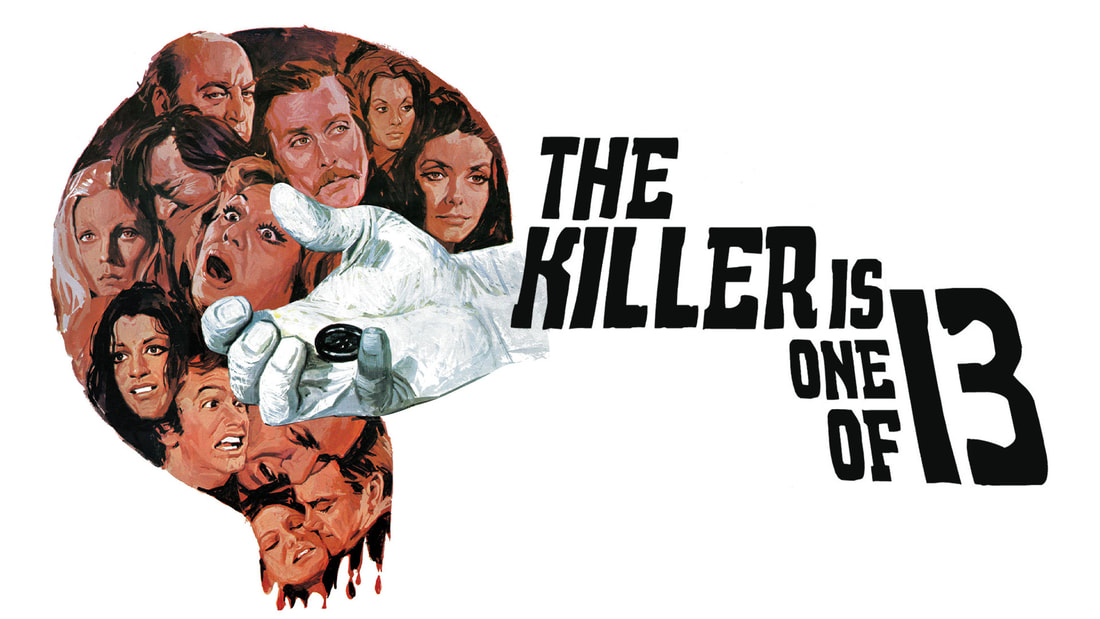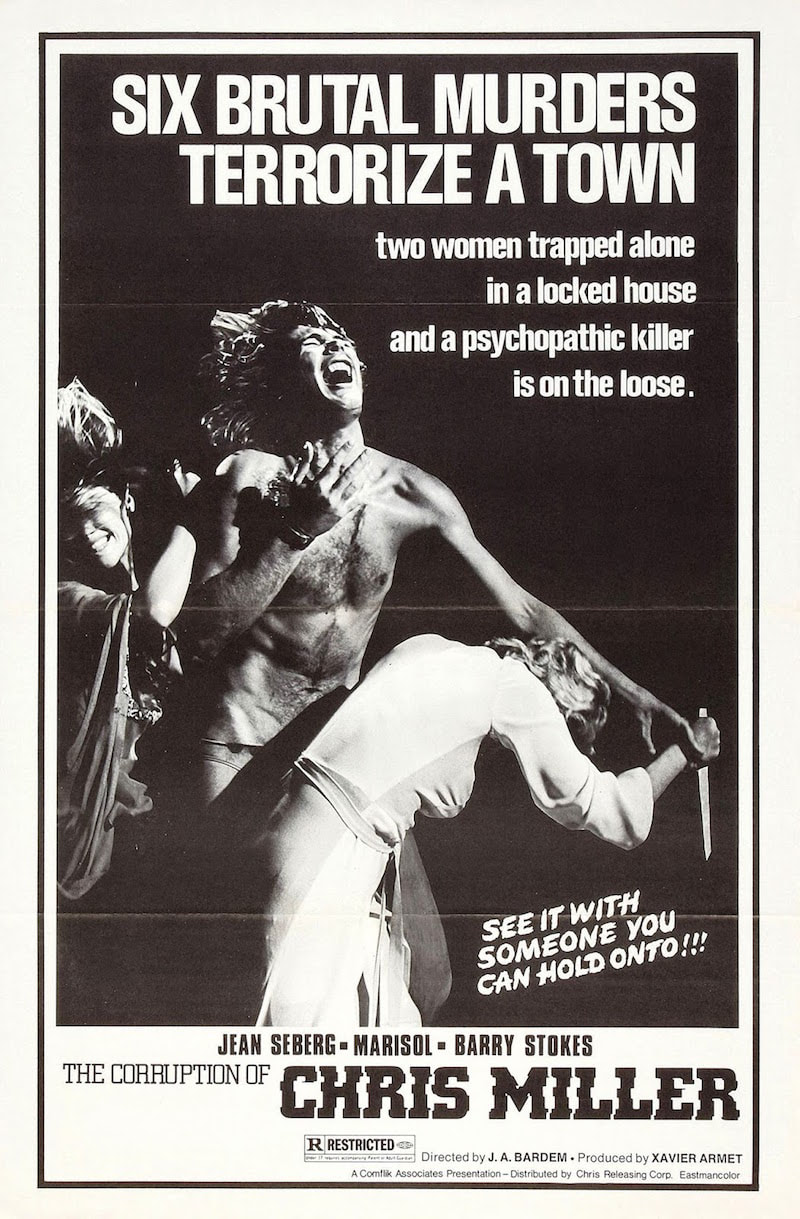Two years after her husband Carlos died in a plane crash, Lisa Mandel invites thirteen of the couple's friends, acquaintances and incestuous family members to her countryside villa in Spain, I mean England. Over the course of a couple of meals (comprising the first half of the film's running time), she explains that she suspects that her husband was murdered (more on this anon) and then explains the motivation behind each guest's invitation, which doubles as a potential motivation for their having murdered Carlos Mandel. Almost all of the bourgeois guests have something to hide, and a few of them (the ones who contact fellow guests saying there's-something-we-must-discuss-but-not-right-this-second-I'll-tell-you-what-it-is-later-on) start popping up dead. But which of the thirteen guests for the crime(s) is the killer?
I'll get to that in a moment. But first-as suggested by the lil' reference I just made there to Nine Guests for a Crime, and by the synopsis in general, this is yet another loose adaptation of Ten Little Black Men/Native Americans by Agatha Christie. The opening sequence actually mirrors the novel's beginning-minus the interior monologue of the characters-as everyone converges upon the single location which will be the locus and focus of the mayhem. It's one of the less bombastic adaptations of the book-indeed, as with most Spanish gialli of the era, it doesn't quite overflow with that particular flavour of unpredictability and eccentricity which characterised Italian servings of giallo. In her commentary on the VS Blu, Kat Ellinger speaks of how Spanish gialli are often considered to be the "poor cousin" of the Italian ones-the Francis to the Lisa, if you will (watch the film and you'll appreciate that)-a reputation which I would argue is, on balance, fully justified.
And that's the case here-it's not a bad film at all, but it's not a top-of-the-range giallo. The first death actually occurs after 63 minutes (as does the second death, to be fair), and the film constantly dances around the concept of sex without fully engaging (likely for censorious reasons, as noted above). This can be somewhat explained by the film's setting-or nominal setting, as you'd have to be pretty damn gullible to take its depiction of upper crust English society at face value. Even though 1970s Britain wasn't quite as repressed in some respects as it's portrayed here (divorce, introduced to the country by Henry VIII, wasn't considered half as scandalous as the Spanish filmmakers seemed to think), the obsession with class and a certain obsession with (and simultaneous fear of) sex isn't without some foundation in reality. The murder sequences are fine, if sparse-it seems odd to gather thirteen potential victims and leave most of them alive come the end of the film. That's not just me being blood-lusty, by the way-they're presented as mostly belonging to that class of obnoxious, self-obsessed people who make a big deal of standing on ceremony in public but are hiding all sorts of dirty laundry in private, so seem perfectly primed to act as cannon fodder.
This dirty laundry is thoroughly aired in the film's first half, as Patty Shepard's Lisa systematically reveals their darkest secrets, AKA their potential motivations for murdering her husband (and their obsession with repression and manners presumably explains why they all remain as guests of the villa even after she essentially accuses them of murder). The lengthy scene in which Lisa runs through these motives is actually pretty well handled by director Javier Aguirre, given the amount of information and characters on/around the table. The scene plays almost like the denouement of an old-fashioned drawing room mystery, except Lisa's not revealing the fruits of her research in order to make an ultimate accusation, but rather to let everyone know that she holds the knowledge, and thus the power (and it's also-let's face it-primarily for the expository benefit of the film's audience). Lisa speaks some wise words in the first half of the film, which neatly summarises the futility of apportioning guilt based on circumstantial evidence: "knowing the motive would be the same as knowing the killer." In other words, examining everyone's various potential reasons to kill will get you nowhere, as one hypothetical motive is as good as another. The only way to know the actual motive is to first identify the actual killer and work backwards. And, even at that, murder isn't rational, nor does a motive have to make sense. This is a flaw inherent in the Nero Wolfe/Hercule Poirot method of psychological detecting, which relies firstly on the accumulation of knowledge, followed by the extrapolation of motive from this knowledge. But a sane mind, no matter how brilliant, cannot always second-guess the inner machinations of the mad.
But I digress. Lisa proves herself an excellent evidence-based detective, in that she is instrumental in pushing the line of investigation which found that her husband has ingested coffee laced with barbiturates prior to flying (you'd think the police would've picked up on this at the time), and she also identifies the presence of an empty envelope which had contained ten grand withdrawn from the bank by Carlos on the day of his murder as evidence that something fishy went on (again, the police really should've picked up on that). She's also not above indulging in a spot of extrapolation herself-when her servant Henry brings word that the corpse of a guest has been discovered, she announces the news with a mention of the location of the murder, despite not having been told by Henners.
This, contrary to what the sharp-minded among you will assume, is not because (SPOILER) she herself is the killer. And (STILL SPOILER) nor, indeed, is any of the thirteen suspects; Henry's the guilty party. In this way, the film's title actually functions as a form of red herring, something which is fairly novel (for a film). The film plays fair for the most part, and actually inadvertently tips its hand as to the killer's identity in a manner I've never really seen before-by turning down an obvious opportunity to present him as a red herring. The scene in question comes when one character says that she feels the killer is always there, watching, listening. We know that Henry has gone upstairs to check on this particular character (who turns out to have been a significant figure in his past), so the obvious edit after that line would have been to cut to him, listening outside, bolstering his red herring credentials. But Aguirre eschews this opportunity, which, to me anyway, seemed highly suspicious-either Aguirre is being extremely sloppy, losing track of his characters' movements, or else there's a reason why he passes over this obvious opportunity to cast suspicion on Henry (END SPOILERS).
Even though the film doesn't push the envelope in any way-style, music, gore, plot etc are all fairly run-of-the-mill, there are some decent performances, none more decent than that of Simon Andreu, who is so effortlessly charming and dastardly that it really doesn't seem like he's acting at all. (Apparently he's nice in real life, so he was probably acting to some extent, unless he was more of a fuckboy in the early 70s than he is now, in his late 70s [which is rather likely tbh]). His role could've easily been fumbled in a less easily-sleazy pair of hands, as the character is a bit of a sex-obsessed scumbag. He pales in comparison to Francis, Lisa's cousin (more accurately, her dead husband's cousin), though-Franny thinks nothing of rubbing the hand and/or knee of any lady who takes his fancy, and is also fond of comsuming his porno mags in bed. He's a voyeur, spying on the nocturnal activities of one of the hired hands (and the rest of the hands' body, badoom) in a strange sequence which seems to be trying to obscure his identity by matting out all but his eyes (the blue eyes of the broken Frank). Oh, and he's extreeeeeemely close to his mother, who is one of the more reprehensible of a reprehensible bunch of characters.
There are plenty more characters I haven't even mentioned here-there's the theoretically rich but in-reality poor heiress who's forced to resort to... (gulp) waitressing to pay her way; there's Paul Naschy, a chauffeur who manages to incorporate a contractually-obligated topless scene and a fight scene in his minimal screentime, there's Jack Taylor playing a more cynical version of his poet from Female Vampire (but one just as disposed to falling in love easily). There are several spring-autumn romances, and there's a reasonably effective murder mystery, albeit one which necessitates wading through a lot of exposition (with which, as stated, Aguirre does do a more than passable job). One final thought, though, for those of you who've seen it-how the devil does Lisa know the significance of the button?!


 RSS Feed
RSS Feed
